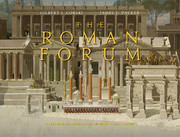Book contents
- Frontmatter
- Map
- Contents
- Preface
- Acknowledgments
- Part I. Architecture in the Roman Forum during the Empire: A Brief History
- Part II. The Monuments
- 3 The Temple of Antoninus and Faustina
- 4 The Temple of Caesar (Aedes divi Iuli)
- 5 The Basilica Æmilia
- 6 The Curia
- 7 The Arch of Septimius Severus
- 8 Minor Monuments
- 9 The Temple of Concord
- 10 The Temple of Vespasian
- 11 The Tabularium
- 12 The Portico of the Dei Consentes
- 13 The Temple of Saturn
- 14 The Basilica Julia
- 15 The Arch of Tiberius
- 16 The Schola Xanthi
- 17 The Diocletianic Honorary Columns
- 18 The Temple of Castor and Pollux
- 19 The Parthian Arch of Augustus (19 BCE)
- 20 The Temple of Vesta
- Part III. Conclusions
- Glossary
- Notes
- Bibliography
- Sources for Coin Images from the Internet and for Other Images
- Index
19 - The Parthian Arch of Augustus (19 BCE)
from Part II. - The Monuments
Published online by Cambridge University Press: 05 March 2015
- Frontmatter
- Map
- Contents
- Preface
- Acknowledgments
- Part I. Architecture in the Roman Forum during the Empire: A Brief History
- Part II. The Monuments
- 3 The Temple of Antoninus and Faustina
- 4 The Temple of Caesar (Aedes divi Iuli)
- 5 The Basilica Æmilia
- 6 The Curia
- 7 The Arch of Septimius Severus
- 8 Minor Monuments
- 9 The Temple of Concord
- 10 The Temple of Vespasian
- 11 The Tabularium
- 12 The Portico of the Dei Consentes
- 13 The Temple of Saturn
- 14 The Basilica Julia
- 15 The Arch of Tiberius
- 16 The Schola Xanthi
- 17 The Diocletianic Honorary Columns
- 18 The Temple of Castor and Pollux
- 19 The Parthian Arch of Augustus (19 BCE)
- 20 The Temple of Vesta
- Part III. Conclusions
- Glossary
- Notes
- Bibliography
- Sources for Coin Images from the Internet and for Other Images
- Index
Summary
Crassus in Parthia
On May 6, 53 BCE, Marcus Licinius Crassus, triumvir with Pompey and Caesar, consul in 55 BCE, arrived near Carrhae, a small town near the Balihu River, a tributary of the Euphrates in northwest Mesopotamia. He was marching to the western Parthian capital of Seleucia with seven legions of heavily armed troops, 4,000 cavalry, and 4,000 light-armed soldiers, a massive expeditionary force totaling between 42,000 and 50,000 men. If all went according to plan, he would capture Seleucia and conquer Parthia, an achievement that would provide him with a military reputation equal to that of his fellow triumvirs. Unfortunately, he had neither the military ability of Pompey nor the genius of Caesar, and his Parthian campaign had been unpopular when proposed in Rome. Had Crassus not been ambitious, wrote Cicero later, he would never have crossed the Euphrates. A tribune, Gaius Ateius Capito, and a large band of his adherents opposed the departure of the expedition on the grounds that “anyone should go out to wage war on men who had done the state no wrong, but were in treaty relations with it.” Yet, since Pompey accompanied the troops out of the city, when they (Ateius’ followers) saw
Pompey’s beaming countenance in front of him [Crassus], they were mollified and gave way in silence….but Ateius ran on ahead to the city gate, placed there a blazing brazier, and when Crassus came up, cast incense and libations upon it, and invoked curses which were dreadful and terrifying in themselves, and were reinforced by sundry strange and dreadful gods, whom he summoned and called by name. The Romans say that these mysterious and ancient curses have such power that no one involved in them ever escapes, and misfortune falls also upon the one who utters them ... accordingly at this time they found fault with Ateius because it was for the city’s sake that he was angered at Crassus, and yet he had involved the city in curses which awakened much superstitious terror.
This was the first of many evil omens.
- Type
- Chapter
- Information
- The Roman ForumA Reconstruction and Architectural Guide, pp. 301 - 312Publisher: Cambridge University PressPrint publication year: 2015



